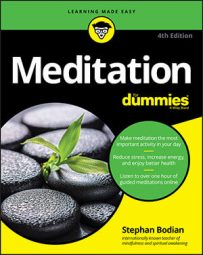Washing the dishes
If you set aside your judgments, which may insist you should be doing something more meaningful or constructive with your time, and instead simply wash the dishes — or sweep the floor or scrub the tub — you may find that you actually enjoy the activity.Feel the contours of the plates and bowls as you clean them. Notice the smell and the slipperiness of the soap, the sounds of the utensils, the satisfying feeling of removing the old food and leaving the dishes clean and ready for use.
Working at your computer
As you become engrossed in the information flashing across your screen, you may find yourself losing touch with your body and your surroundings. Pause every now and then to follow your breathing and notice how you’re sitting. If you’re starting to tense up and crane your head forward, gently straighten your spine and relax your body. During recurring gaps in the flow of your work, come back to your body, breathe, and relax.Driving your car
What could possibly be more stressful than navigating an automobile through heavy traffic? Besides the constant stop and go, you need to be aware of potential problems in every direction, any one of which could pose a threat to your safety. Yet you add to the stress of driving when you hurry to get to your destination faster than you realistically can and then get angry and impatient in the process.As an antidote to the stress, practice mindfulness while you drive. Take a few deep breaths before you start and return to your breathing again and again as you consciously let go of tension and stress. Feel the steering wheel in your hands, the pressure of your feet against the pedals, the weight of your body against the seat.
Notice any tendency to criticize other drivers, to space out, or to become angry or impatient. Pay attention to how the music or talk shows you listen to affect your mood as you drive. When you wake up and pay attention, you may be surprised to realize that you and the people around you are actually piloting these 2,000-pound hunks of plastic and steel with precious, vulnerable beings inside. And you may feel more inclined to drive mindfully and safely as a result.
Talking on the phone
As you engage in conversation, stay connected with your breathing and notice how you’re affected. Do certain topics bring up anger, fear, or sadness? Do others bring up pleasure or joy? Do you become reactive or defensive?Notice also what moves or motivates you to speak. Are you attempting to influence or convince this person in some way? Do you have a hidden agenda of jealousy or resentment, or possibly a desire to be loved or appreciated? Or are you simply open and responsive to what’s being said in the moment, without the overlay of past or future?
Watching TV
Just as when you work at a computer, you can easily forget you have a body when you tune in to the tube. Take a break during commercials to turn down the sound, follow your breathing, and ground your awareness in the present moment.Walk around, look out the window, connect with your family members. (Like many people, you may use food to ground you in your body while you’re watching TV, but it won’t work unless you’re mindful of what you’re eating. Besides, mindless eating has its price, as any couch potato can tell you.)
Working out
Physical exercise offers you a wonderful opportunity to shift your awareness from your mind to the simple, repetitive movements of your body. Unfortunately, many people just put on the headphones, switch on their music player, and space out.The next time you hit the exercise equipment or attend an aerobics class, make a point of following your breathing as much as you can. Even if the routine is a challenging one, you can still keep coming back to your breath. Or simply be mindful of your body as you move — the flexing of your muscles, the contact with the equipment (or the floor), the feelings of warmth or pleasure or strain.
Notice also what takes you away. Do you worry about your body image or obsess about your weight? Do you fantasize about your new physique and forget to be present for what’s happening right now? Just notice what’s occurring and then return to your experience. You may start enjoying your body so much that you stop caring how others see it.

